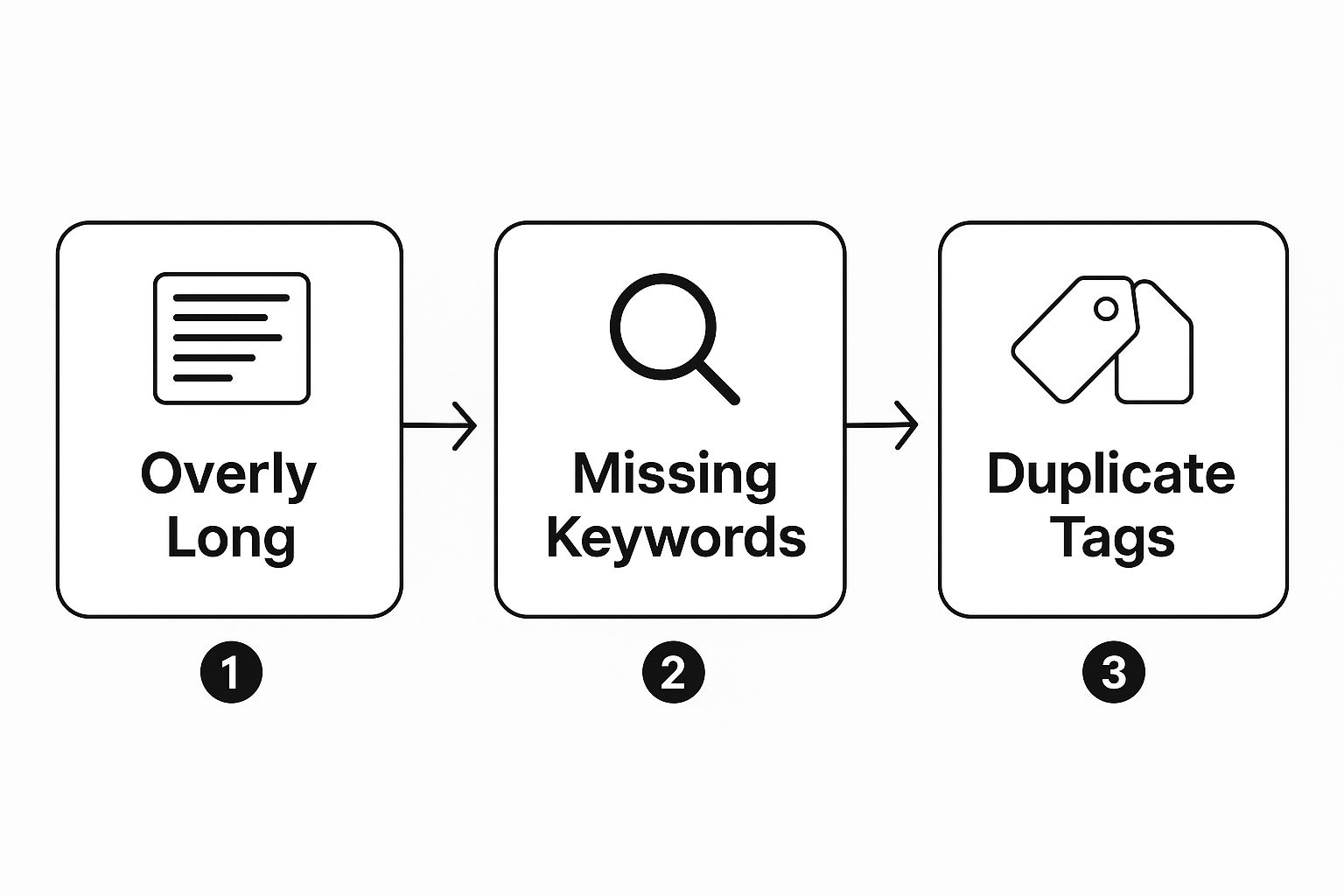
How to Write Meta Descriptions That Get Clicks
Share
Writing a great meta description is all about making a promise. You're giving searchers a sneak peek of your page, and your goal is to convince them that you have the answer they're looking for. It's a blend of smart keyword use and persuasive copy, all packed into about 155 characters.
So, Do Meta Descriptions Still Matter for SEO?
Let's cut to the chase: absolutely. I hear this question all the time. While Google has confirmed that meta descriptions aren't a direct ranking factor anymore, their impact on your SEO is undeniable. They are your one shot to grab a searcher's attention on a crowded results page.
Think of it as your elevator pitch on the SERP. A boring, generic description gets ignored. A compelling one gets the click. And a higher click-through rate (CTR) is a massive signal to Google that your page is a great match for that search query.
When more people click on your result compared to others, it tells Google your page is relevant and valuable. This can indirectly boost your rankings over time. It’s a crucial piece of the on-page SEO puzzle.
More Than Just a Click
A good description does more than just earn you a visit; it sets the right expectations from the get-go.
When a user clicks through and the page delivers exactly what the description promised, they stick around. This lowers your bounce rate and starts building trust immediately. This positive first impression is a cornerstone of any solid on-page strategy. For a deeper dive, check out our guide on what is on-page optimization.
To make sure your pitch lands, you have to play by the rules—specifically, the character count. The sweet spot for 2025 is between 140 and 160 characters. Go much longer, and Google will likely chop it off with an awkward "..." especially on mobile. That’s a surefire way to kill your message before anyone even reads it.
Crafting a Compelling Meta Description

So, what separates a boring meta description from one that practically begs to be clicked? I've found it's a mix of persuasive science and smart writing. An effective description goes way beyond just listing features; it needs to speak directly to what the searcher is trying to solve.
The first step is learning to write in an active, engaging voice. Think of it as talking directly to your potential customer through the search results. This simple shift creates an immediate connection and helps your link stand out in a sea of generic, passive statements.
Focus on Benefits and Actions
A great meta description always answers the searcher's unspoken question: "What's in it for me?" Don't just tell them what your product is; explain what it does for their business. If you're selling restaurant equipment, this means highlighting things like improved efficiency, rugged durability, or long-term cost savings.
Once you’ve hooked them with the benefits, add a clear and direct call-to-action (CTA). Simple phrases like "Discover," "Explore," or "Shop Now" tell people exactly what to do next. This transforms your description from a passive summary into an active invitation, which can make a real difference in your click-through rates.
The best meta descriptions act as a micro-sales pitch. They address a pain point, present a solution (your page), and include a clear next step, all within about 155 characters.
If you're looking for more in-depth techniques, there are some great strategies for writing meta descriptions that get clicks that can help you refine your approach even further.
To see this in action, check out the difference a few tweaks can make. The table below shows a typical, uninspired meta description and how we can inject life and value into it.
Transforming a Meta Description From Bland to Compelling
| Element | Before (Weak Example) | After (Optimized Example) |
|---|---|---|
| Tone | Passive and generic | Active and benefit-driven |
| Description | This page has commercial refrigerators. We sell many types of units for restaurants and kitchens. | Keep ingredients fresh with our durable commercial refrigerators. Explore energy-efficient models with 24/7 support & fast shipping. Shop now! |
| Impact | Fails to engage or differentiate from competitors. | Highlights key benefits (durability, energy efficiency), builds trust (24/7 support), and includes a clear CTA. |
See the difference? The "After" version is much more powerful. It speaks directly to the needs of a busy restaurant owner—freshness, efficiency, and reliable support—making it far more likely to earn that click from someone ready to buy.
Advanced Techniques for Standout Descriptions

Alright, you’ve got the fundamentals down. Now, let’s talk about how to write descriptions that don’t just show up in search results but actually win the click. It’s all about infusing your brand's unique personality into those 155 characters.
Think about it. Is your brand voice professional and authoritative? Witty and fun? Straightforward and no-nonsense? Whatever it is, that voice needs to come through loud and clear. This is your first chance to build a connection and stand out from a sea of generic, cookie-cutter search results.
Using Emotional Triggers and Specificity
The most effective descriptions I've ever written are the ones that tap directly into a chef or restaurant owner's biggest headaches and aspirations. Don't just list features; talk about the problems your equipment solves.
Let's take a commercial oven page. A lazy description might say, "High-quality commercial ovens for sale." It's fine, but it's not compelling.
Now try this: "Stop worrying about downtime. Our convection ovens deliver consistent results during your busiest dinner rush." See the difference? That second one speaks directly to a real-world business fear. It connects.
Specificity is your other secret weapon. It helps pre-qualify your audience, so you attract clicks from people who are serious about buying. Sprinkling in key details like model numbers, pricing, or unique features can work wonders.
- On Product Pages: Mention something concrete, like "Energy Star certified" or "durable stainless steel construction."
- On Category Pages: Highlight a real selling point, such as "free shipping on all ice machines."
- On Blog Posts: Show the value upfront. We do this by turning a complex topic into easy-to-follow advice in our title tags examples for restaurants.
A great meta description doesn't just describe; it persuades. It zeroes in on a specific user need and presents your page as the clear, benefit-driven solution. That's what convinces someone to choose your result over all the others.
And if you're using AI to help brainstorm ideas, getting your prompts right is half the battle. Learning to craft tailored ChatGPT prompts for digital marketers can help you get copy that sounds less robotic and more aligned with what your audience actually wants to read.
Common Meta Description Mistakes to Avoid

It’s surprisingly easy to undercut a great page with a poorly written meta description. Over the years, I've seen some recurring issues that trip up even seasoned restaurant equipment sellers. Steering clear of these traps is every bit as crucial as nailing the best practices.
The most common slip-up? Lazily copying and pasting the same description across multiple pages. This not only looks like duplicate content to search engines but also gives users a generic, unhelpful preview. Every single page, whether it’s for a Hoshizaki ice machine or a Garland convection oven, needs its own unique, compelling pitch.
Outdated and Harmful Tactics
Another mistake I still see is a hangover from old-school SEO: keyword stuffing. Shoving phrases like "commercial refrigerator, restaurant refrigerator, best refrigerator" into the description is a massive red flag for both Google and your potential customers. It reads like spam and does absolutely nothing to entice a real person to click. For more on finding that sweet spot, check out our guide on how many keywords to target per page.
Just as bad is what I call the "bait-and-switch." This is when the meta description promises something the page can't deliver—like a "50% off sale" that isn't actually happening. That’s a one-way ticket to a sky-high bounce rate, which signals to Google that your page is a poor result for that search.
Key Takeaway: The goal is to build trust from the very first impression on the search results page. A misleading description shatters that trust immediately, damaging your reputation and long-term SEO.
Google has gotten much smarter. It now favors unique descriptions that truly align with what the user is looking for, rather than just matching keywords. In fact, if your meta description is weak or irrelevant, Google will often ignore it and create its own snippet from your page content. You can read more about how Google generates these snippets directly from their documentation.
At the end of the day, think of your meta description as a promise to the searcher. Make sure it's one you can keep.
How to Audit and Improve Existing Descriptions
Crafting the perfect meta description isn't a "set it and forget it" task. It’s more like a constant process of tuning and tweaking. The best way to start improving what you already have is by hunting for the low-hanging fruit—those pages with massive potential that are just not pulling their weight.
Your first stop for this audit should always be Google Search Console. Dive into your performance report and look for pages that are racking up a ton of impressions but have a disappointingly low click-through rate (CTR). This is the classic red flag for a weak meta description. It tells you the page is ranking and people are seeing it, but your little SERP advertisement isn't compelling enough to earn the click.
Prioritize and Test Your Changes
Once you've got your list of underperformers, you need a smart plan of attack. Don't just start with the page that has the absolute worst CTR. Instead, think about business impact. Where can a small improvement make the biggest difference?
Focus on your high-value pages first. Think top-level product categories like "Commercial Refrigerators" or your best-selling individual products. Boosting the CTR on a page that already drives significant revenue will have a much more immediate and noticeable impact on your bottom line.
A good way to prioritize your list is to look for:
- High Impression, Low CTR Pages: These are your prime targets.
- Key Product & Category Pages: Go after the pages that are closest to a sale.
- Top-Performing Blog Posts: A quick refresh on these can bring in a fresh wave of qualified traffic.
So, how do you know if your changes are actually working? Simple A/B testing is your friend here. Tweak the description on a key page and then keep a close eye on its CTR in Search Console over the next few weeks. Try out different calls-to-action ("Shop Now vs. "See Prices") or highlight different benefits ("Durable Stainless Steel" vs. "Energy Efficient Design") to see what truly connects with restaurant owners and chefs.
This visual breakdown shows some of the most common mistakes I see when auditing client sites.

As you can see, problems like descriptions that are too long, missing keywords, or just duplicated across multiple pages are often the main culprits dragging down SERP performance. Fix those, and you're already halfway there.
Common Questions About Meta Descriptions
Even after you get the hang of writing meta descriptions, a few questions always seem to pop up. Let’s clear the air on some of the most common ones I hear from folks in the restaurant equipment space.
https://www.youtube.com/embed/zFMgpxG-chM
Will Google Always Use My Meta Description?
The short answer is no, and this is a big one to remember. Google's main goal is to satisfy the user, so if it thinks a different snippet from your page content better matches a specific search, it will show that instead.
So, is writing a meta description a waste of time? Absolutely not. It’s still your best shot at controlling the message. A well-crafted description is what Google will use most of the time.
Think of it like this: your meta description is your preferred ad copy. Even if Google sometimes improvises, giving it a fantastic script makes it much more likely they'll stick to it.
Should I Bother With Numbers Or Special Characters?
Yes! When used thoughtfully, they can be a game-changer. Specific numbers or symbols can make your description stand out in a sea of text-only search results.
- Product Pages: You can catch someone's eye by mentioning things like "2-year warranty," "Save 20%," or "Free Shipping." It's direct and compelling.
- Service & Category Pages: Using a checkmark (✓) or another simple symbol can break up the text and draw attention to key features or benefits.
The key is to make it look natural and add real value, not just to stuff it with symbols. It’s a simple trick, but it really can boost your click-through rate.
At Restaurant Equipment SEO, we translate these best practices into tangible results. We're here to help you create descriptions that don't just get clicks but bring in qualified buyers. Find out more about our specialized SEO services at https://restaurantequipmentseo.com.